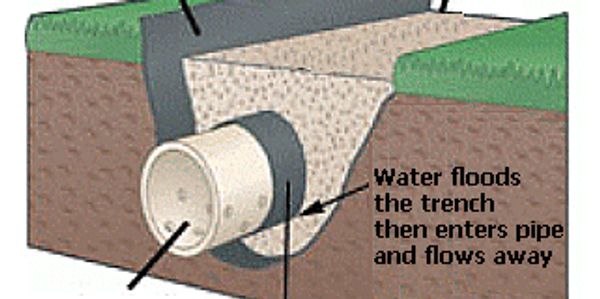French Drains Protect Lawns and Prevent Foundation Problems
French drains protect Louisiana yards from water damage and foundation problems. In a state where fast storms drop inches of rain in a single afternoon, yard drainage defines how well a property holds up. A French drain collects runoff below the surface and redirects it to a safe discharge point, which keeps grass healthy, flower beds intact, and moisture away from your slab or pier and beam supports. This simple system removes the water that causes puddles, erosion, and musty crawl spaces, and it does it out of sight.

Why French Drains Work Well in Louisiana
Clay heavy soils and flat lots slow infiltration. When soil stays saturated, water spreads toward the low point, which often sits near a foundation or along fence lines. French drains establish a predictable path for water to follow. The trench and pipe give water a lower resistance route, so gravity moves it away before it pools. Because the system hides underground, it preserves the clean look of the landscape.
How a French Drain Works
A French drain uses a sloped trench, washed gravel, and a perforated pipe to capture and convey water. Water flows through the gravel, enters the pipe through small slots, and travels to a discharge point such as a curb drain, a dry well, or a daylight outlet at a lower grade. Landscape fabric separates soil from the gravel to reduce sediment and keep the system clear. The finished surface can be soil and turf, decorative rock, or a narrow mulch strip.
Common Drainage Problems a French Drain Solves
- Standing water that lingers for days after rain
- Muddy areas that thin grass and invite weeds
- Pooling near the foundation that seeps into cracks
- Erosion that strips mulch and topsoil from beds
- Shallow puddles that become mosquito breeding zones
French Drain Benefits and Effects
| Benefit | Effect |
|---|---|
| Water Redirection | Moves water away from low areas and foundations |
| Lawn Protection | Prevents saturation that kills turf and exposes soil |
| Soil Stability | Reduces erosion and keeps mulch in place |
| Foundation Defense | Limits seepage, cracking, and soil movement at the slab |
| Year Round Service | Performs through spring storms, summer downpours, and winter rains |
Installation Process for a French Drain
- Site Evaluation A drainage specialist maps high and low points, checks soil type, and identifies safe discharge locations.
- Layout and Slope The route sets a consistent fall, often one percent or more, to keep water moving by gravity.
- Trench Excavation A narrow trench follows the layout, deep enough for gravel, pipe, and cover.
- Base and Pipe Clean gravel forms a bed, a perforated pipe lays bell up, and more gravel surrounds the pipe.
- Fabric and Backfill Landscape fabric wraps the gravel, then soil, sod, or stone restores the surface.
- Discharge Buildout The line terminates at a curb drain, dry well, or daylight outlet with erosion control.
Seasonal Performance and Care
Spring storms test infiltration, and a French drain passes that test by pulling water underground. Summer heat dries the surface while the drain moves what remains. Fall leaf drop can clog surface grates, but a French drain continues to work because the intake sits below the debris layer. Winter cold slows percolation, and the drain still carries water to the outlet. A quick visual check after major rain confirms clear outlets and stable backfill.
French Drain Compared to Other Solutions
Surface channel drains collect water but require frequent cleaning. Single catch basins help a small pocket but miss broad sheet flow. Regrading improves slope but may not solve a perched water table. A French drain handles subsurface movement and pairs well with these methods for complete control. Many lots benefit from a hybrid plan that uses yard grading at the surface and a French drain below grade.
Maintenance Tips for Long Lasting Drains
- Keep the discharge point clear of leaves and silt
- Inspect the route each season for settling or root intrusion
- Flush cleanouts if flow slows after a major storm
- Preserve fabric and gravel during any future digging near the line
Integrating French Drains with Landscape Design
Drainage works best as part of a complete plan. A coordinated design sets bed edges, turf lines, and hardscape so water always has a safe path. Pairing your drain with landscape design brings structure and flow to the whole yard. Balancing irrigation output with a sprinkler system installation keeps soil moisture in the healthy range without overloading low spots.
Cost and Value
A French drain requires excavation, materials, and skilled labor, and the return arrives in several forms. The system prevents foundation movement that leads to expensive repairs. The system preserves turf and beds so you avoid constant patching. The system expands usable yard days because water clears faster after storms. Buyers notice a dry, stable lawn, which supports resale value.
FAQ
How long does a French drain last
A properly built French drain lasts for decades. Washed gravel, quality pipe, and correct slope keep water moving and reduce sediment buildup.
How deep should a French drain be installed
Most residential lines sit between 18 and 24 inches deep. Depth can change with soil type, root zones, and the location of utility lines.
Does a French drain need a pump
Most lots use gravity flow. A sump pump helps only when the outlet sits higher than the collection zone or when the lot has very little fall.
Will a French drain stop mosquitoes
Yes. By removing standing water, the system removes breeding areas and reduces mosquito pressure across the yard.
Can a French drain sit next to a foundation
Yes. A perimeter French drain protects the slab and moves water to a controlled outlet, which lowers moisture stress on the structure.
Clean Cut Expertise in French Drains
Clean Cut Landscape designs and installs French drains for Louisiana soils and weather patterns. The team studies slope, soil texture, and runoff paths, then builds a route that carries water out without disrupting the look of the yard. The crew restores turf and beds with a neat finish so the drain works quietly in the background while your landscape stays dry and usable.
Related Resource
Study the fundamentals of a French drain to see how subsurface drainage improves site performance.
Takeaway
French drains protect Louisiana properties by moving water off the lawn and away from the foundation with steady, reliable flow. A well designed route, clean gravel, and correct slope produce fast relief after storms, stronger turf during the season, and a drier, safer home year round. When you want a yard that looks clean and drains right, Clean Cut Landscape delivers a French drain system that works and a landscape plan that ties everything together.




